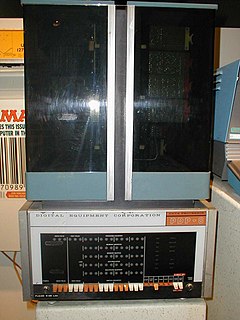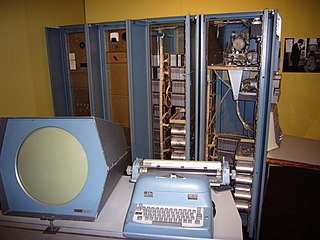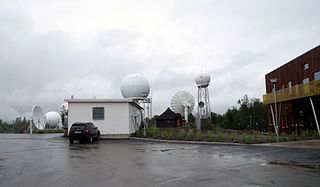
A minicomputer, or colloquially mini, is a class of smaller general purpose computers that developed in the mid-1960s and sold for much less than mainframe and mid-size computers from IBM and its direct competitors. In a 1970 survey, The New York Times suggested a consensus definition of a minicomputer as a machine costing less than US$25,000, with an input-output device such as a teleprinter and at least four thousand words of memory, that is capable of running programs in a higher level language, such as Fortran or BASIC.

Programmed Data Processor (PDP), referred to by some customers, media and authors as "Programmable Data Processor," is a term used by the Digital Equipment Corporation from 1957 to 1990 for several lines of minicomputers. The name "PDP" intentionally avoids the use of the term "computer" because, at the time of the first PDPs, computers had a reputation of being large, complicated, and expensive machines, and the venture capitalists behind Digital would not support Digital's attempting to build a "computer"; the word "minicomputer" had not yet been coined. So instead, Digital used their existing line of logic modules to build a Programmed Data Processor and aimed it at a market that could not afford the larger computers.

The PDP-11 is a series of 16-bit minicomputers sold by Digital Equipment Corporation (DEC) from 1970 into the 1990s, one of a set of products in the Programmed Data Processor (PDP) series. In total, around 600,000 PDP-11s of all models were sold, making it one of DEC's most successful product lines. The PDP-11 is considered by some experts to be the most popular minicomputer.

A microcomputer is a small, relatively inexpensive computer with a microprocessor as its central processing unit (CPU). It includes a microprocessor, memory and minimal input/output (I/O) circuitry mounted on a single printed circuit board (PCB). Microcomputers became popular in the 1970s and 1980s with the advent of increasingly powerful microprocessors. The predecessors to these computers, mainframes and minicomputers, were comparatively much larger and more expensive. Many microcomputers are also personal computers.

Data General was one of the first minicomputer firms of the late 1960s. Three of the four founders were former employees of Digital Equipment Corporation (DEC).

Norsk Data was a minicomputer manufacturer located in Oslo, Norway. Existing from 1967 to 1998, it had its most active period from the early 1970s to the late 1980s. At the company's peak in 1987 it was the second largest company in Norway and employed over 4,500 people.
A distributed control system (DCS) is a computerised control system for a process or plant usually with many control loops, in which autonomous controllers are distributed throughout the system, but there is no central operator supervisory control. This is in contrast to systems that use centralized controllers; either discrete controllers located at a central control room or within a central computer. The DCS concept increases reliability and reduces installation costs by localising control functions near the process plant, with remote monitoring and supervision.
Sintran is a range of operating systems (OS) for Norsk Data's line of minicomputers. The original version of Sintran, was written in the programming language Fortran, released in 1968, and developed by the Department of Engineering Cybernetics at the Norwegian Institute of Technology together with the affiliated research institute, SINTEF. The different incarnations of the OS shared only name, and to a degree, purpose.

The Data General-One (DG-1) was a portable personal computer introduced in 1984 by minicomputer company Data General.

Nord-10 was a medium-sized general-purpose 16-bit minicomputer designed for multilingual time-sharing applications and for real-time multi-program systems, produced by Norsk Data. It was introduced in 1973. The later follow up model, Nord-10/S, introduced in 1975, introduced CPU cache, paging, and other miscellaneous improvements.

The Model 7/32 and Model 8/32 were 32-bit minicomputers introduced by Perkin-Elmer after they acquired Interdata, Inc., in 1973. Interdata computers are primarily remembered for being the first 32-bit minicomputers under $10,000. The 8/32 was a more powerful machine than the 7/32, with the notable feature of allowing user-programmable microcode to be employed.
Direct numerical control (DNC), also known as distributed numerical control, is a common manufacturing term for networking CNC machine tools. On some CNC machine controllers, the available memory is too small to contain the machining program, so in this case the program is stored in a separate computer and sent directly to the machine, one block at a time. If the computer is connected to a number of machines it can distribute programs to different machines as required. Usually, the manufacturer of the control provides suitable DNC software. However, if this provision is not possible, some software companies provide DNC applications that fulfill the purpose. DNC networking or DNC communication is always required when CAM programs are to run on some CNC machine control.
Sintran III is a real-time, multitasking, multi-user operating system used with Norsk Data minicomputers from 1974. Unlike its predecessors Sintran I and II, it was written entirely by Norsk Data, in Nord Programming Language, an intermediate language for Norsk Data computers.
The Nord-100 was a 16-bit minicomputer series made by Norsk Data, introduced in 1979. It shipped with the Sintran III operating system, and the architecture was based on, and backwards compatible with, the Nord-10 line.
PLANC is a high-level programming language.
Ferranti's Argus computers were a line of industrial control computers offered from the 1960s into the 1980s. Originally designed for a military role, a re-packaged Argus was the first digital computer to be used to directly control an entire factory. They were widely used in a variety of roles in Europe, particularly in the UK, where a small number continue to serve as monitoring and control systems for nuclear reactors.

Tromsø Satellite Station, until 1988 known as Tromsø Telemetry Station, is a satellite earth station located in Tromsø, Norway. The facility is owned by Kongsberg Satellite Services (KSAT), a joint venture between the Kongsberg Group and the Norwegian Space Centre (NSC). In addition to hosting its own antennas serving thirty satellites, TSS acts as the center-point of KSAT's operations and provides backbone services for the high Arctic Svalbard Satellite Station (SvalSat) and the Antarctic Troll Satellite Station (TrollSat).
Simulation for Automatic Machinery or SAM were two unique minicomputers built by the Norwegian Defence Research Establishment (NDRE) in the mid-1960s. SAM 1, built between 1962 and 1964, was the first Norwegian-built programmable computer. It featured 4,096 14-bit words of memory and 14 registers and was used in-house at NDRE. SAM 2 was built between 1966 and 1967 and was used for analysis of satellite imagery at Tromsø Satellite Station. A third-generation computer, it was among the first three in the world to use integrated circuits.

Norsk Data (ND) was a Norwegian manufacturer of minicomputers which operated between 1967 and 1992. The company was established as A/S Nordata – Norsk Data-Elektronikk on 7 July 1967 and took into use the Norsk Data brand in 1975. The company was founded by Lars Monrad-Krohn, Rolf Skår and Per Bjørge, three computer engineers working at the Norwegian Defence Research Establishment which had just built the minicomputer SAM 2. ND's first contract was the delivery of a Nord-1 computer to Norcontrol. Initially in competition with Kongsberg, ND started delivering computers to Norwegian institutions. By 1972 the company had developed Sintran operating system, the 32-bit Nord-5 and a time sharing system.
The Research and Development Network in Norway or FUNN was fourteen computing centers established in regional districts in Norway established by Norsk Data (ND) and the Ministry of Trade and Industry in 1989. These were located in Ålesund, Alta, Bø, Gjøvik, Grimstad, Kirkenes, Kristiansund, Mo i Rana, Narvik, Sarpsborg, Sogndal, Steinkjer, Stord and Tromsø. Each had two Norsk Data-built minicomputers, one running Sintran III and one running Unix. Participating agencies included the Regional Development Fund, the Ministry of Local Government and Regional Development, the Norwegian Telecommunications Administration (NTA) and the Royal Norwegian Council for Scientific and Industrial Research (NTNF).










